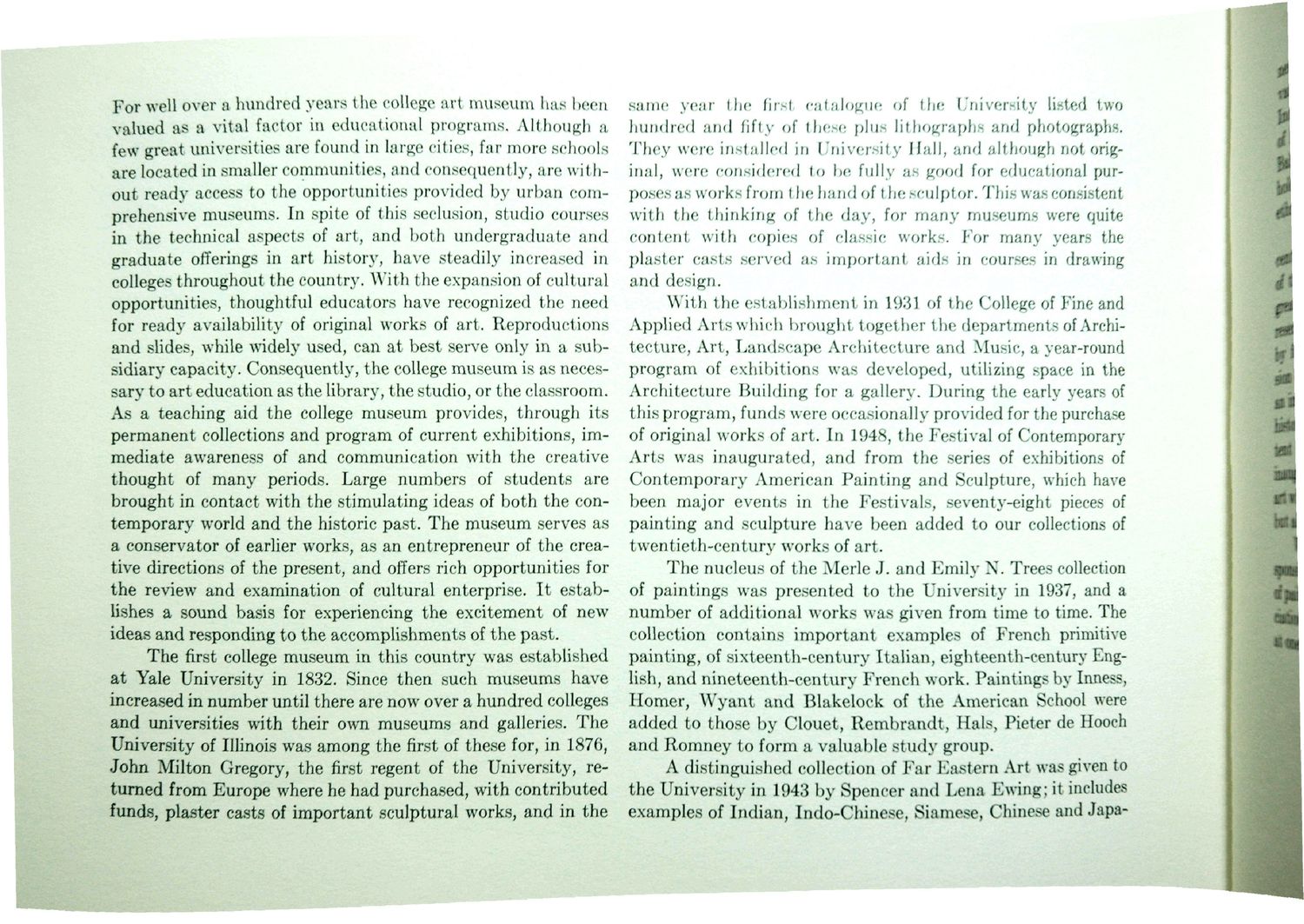| |
| |
Caption: Dedication - Krannert Art Museum
This is a reduced-resolution page image for fast online browsing.

EXTRACTED TEXT FROM PAGE:
For well over a hundred years the college art museum has been valued as a vital factor in educational programs. Although a few great universities are found in large cities, far more schools are located in smaller communities, and consequently, are without ready access to the opportunities provided by urban comprehensive museums. In spite of this seclusion, studio courses in the technical aspects of art, and both undergraduate and graduate offerings in art history, have steadily increased in colleges throughout the country. With the expansion of cultural opportunities, thoughtful educators have recognized the need for ready availability of original works of art. Reproductions and slides, while widely used, can at best serve only in a subsidiary capacity. Consequently, the college museum is as necessary to art education as the library, the studio, or the classroom. As a teaching aid the college museum provides, through its permanent collections and program of current exhibitions, immediate awareness of and communication with the creative thought of many periods. Large numbers of students are brought in contact with the stimulating ideas of both the contemporary world and the historic past. The museum serves as a conservator of earlier works, as an entrepreneur of the creative directions of the present, and offers rich opportunities for the review and examination of cultural enterprise. It establishes a sound basis for experiencing the excitement of new ideas and responding to the accomplishments of the past. The first college museum in this country was established at Yale University in 1832. Since then such museums have increased in number until there are now over a hundred colleges and universities with their own museums and galleries. The University of Illinois was among the first of these for, in 1876, John Milton Gregory, the first regent of the University, returned from Europe where he had purchased, with contributed funds, plaster casts of important sculptural works, and in the same year the first catalogue of the University listed two hundred and fifty of these plus lithographs and photographs. They were installed in University Hall, and although not original, were considered to be fully as good for educational purposes as works from the hand of the sculptor. This was consistent with the thinking of the day, for many museums were quite content with copies of classic works. For many years the plaster casts served as important aids in courses in drawing and design. With the establishment in 1931 of the College of Fine and Applied Arts which brought together the departments of Architecture, Art, Landscape Architecture and Music, a year-round program of exhibitions was developed, utilizing space in the Architecture Building for a gallery. During the early years of this program, funds were occasionally provided for the purchase of original works of art. In 1948, the Festival of Contemporary Arts was inaugurated, and from the series of exhibitions of Contemporary American Painting and Sculpture, which have been major events in the Festivals, seventy-eight pieces of painting and sculpture have been added to our collections of twentieth-century works of art. The nucleus of the Merle J. and Emily N. Trees collection of paintings was presented to the University in 1937, and a number of additional works was given from time to time. The collection contains important examples of French primitive painting, of sixteenth-century Italian, eighteenth-century English, and nineteenth-century French work. Paintings by Inness, Homer, Wyant and Blakelock of the American School were added to those by Clouet, Rembrandt, Hals, Pieter de Hooch and Romney to form a valuable study group. A distinguished collection of Far Eastern Art was given to the University in 1943 by Spencer and Lena Ewing; it includes examples of Indian, Indo-Chinese, Siamese, Chinese and Japa-
| |